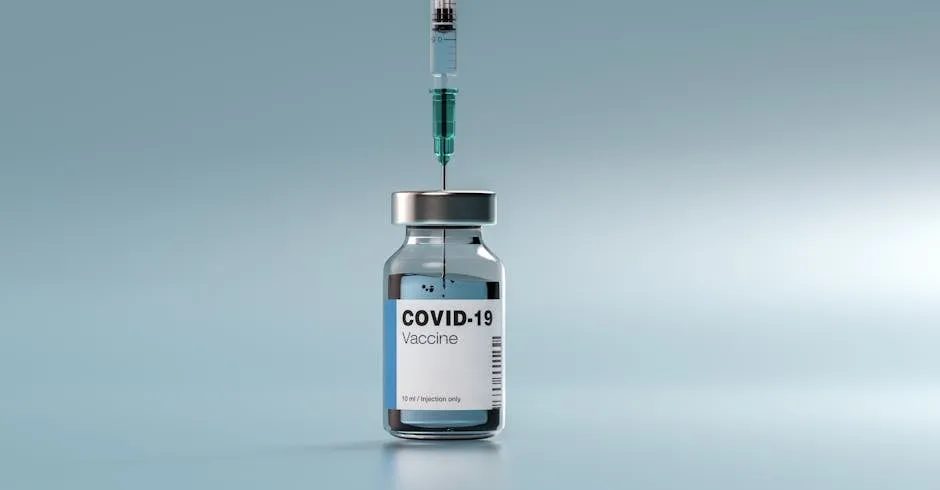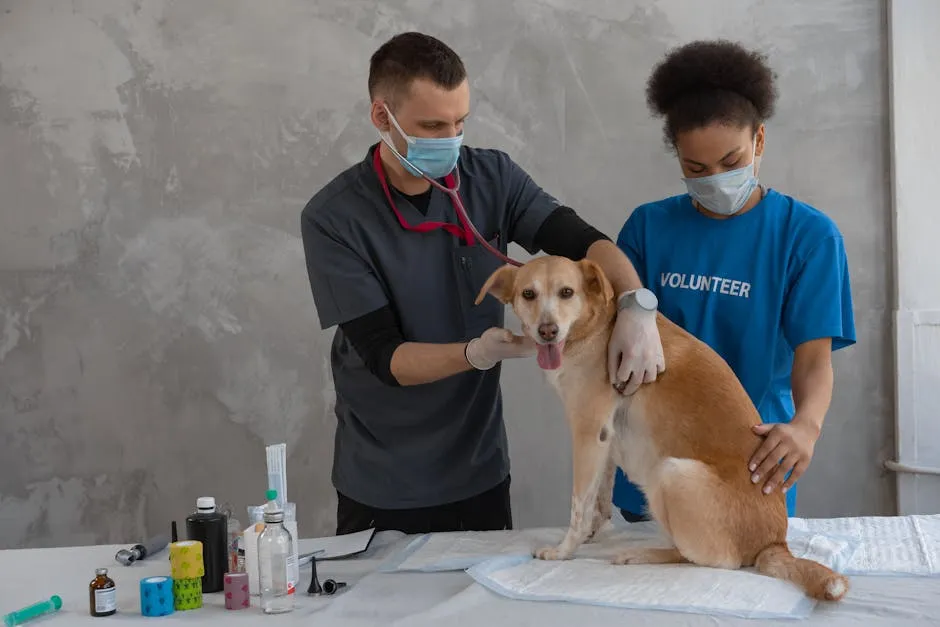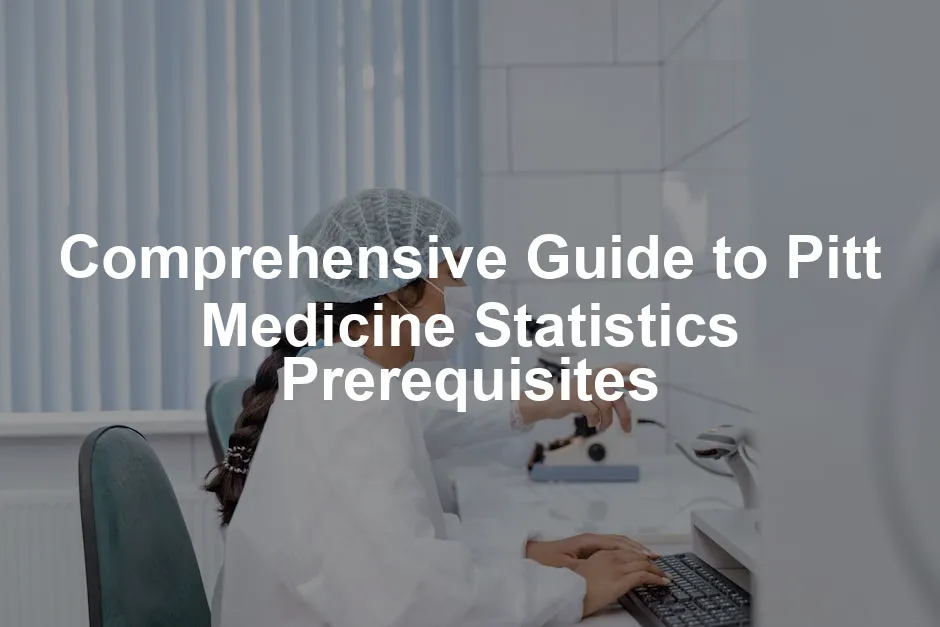Introduction
Understanding the premedical statistics requirements for the University of Pittsburgh School of Medicine (UPSOM) is crucial for aspiring medical students. Statistics is not just a number-crunching exercise; it’s the backbone of medical research and clinical practice. Without it, how would doctors interpret data from studies that could save lives? A firm grasp on statistics can set you apart in the competitive landscape of medical school admissions.
Pitt Medicine is renowned for its academic excellence. It consistently ranks among the top medical schools in the nation. However, this prestige comes with a catch: the admission process is as competitive as a game of dodgeball in a room full of gym class veterans. With an acceptance rate hovering around a mere 3.5%, understanding the prerequisites is not just helpful; it’s essential.
This article aims to break down the prerequisites for Pitt Medicine, specifically focusing on statistics and related courses. We want to arm you with the knowledge necessary to navigate the admissions maze and make your application shine like a freshly polished stethoscope.
Understanding Pitt Medicine Prerequisites
Overview of UPSOM Admission Requirements
To apply to the University of Pittsburgh School of Medicine, candidates must meet several admission requirements. First and foremost, a completed undergraduate degree is necessary. This degree should ideally include a solid grounding in the sciences. Courses in biology, chemistry, and physics are the bread and butter of premedical education. Moreover, UPSOM values diverse educational backgrounds. For example, if your degree is in philosophy, don’t panic! As long as you meet the science prerequisites, you’re still in the running.
Relevant experiences—think internships, volunteer work, and research—are also crucial. Admissions committees seek well-rounded individuals who not only excel academically but also demonstrate a commitment to healthcare and community service. Meeting these prerequisites isn’t just about checking boxes; it’s about showcasing your passion for medicine.

Required Courses for Admission
When it comes to the required courses for UPSOM, statistics plays a starring role, specifically biostatistics. Here’s a breakdown of the necessary courses:
- Biology: One year, including a lab. This course lays the foundation for understanding living organisms, a must for any aspiring doctor.
- General Chemistry: One year with lab work. Chemistry is vital for understanding drug interactions and bodily functions.
- Organic Chemistry: Half a year with lab. This course dives into the chemistry of carbon-containing compounds, which are essential in biochemistry.
- Physics: One year with lab. Physics principles provide insights into the mechanics of bodily systems.
- English/Writing: One year. Strong communication skills are pivotal in medicine, where clear communication can make a difference between life and death.
- Statistics: Half a year, preferably biostatistics. This course is essential for interpreting medical research and understanding data-driven decisions in patient care. Consider taking Biostatistics for Dummies to get a solid grasp on the subject!
These courses equip you with the tools to not only succeed in medical school but also become a competent physician. Understanding the statistical methods behind clinical trials or epidemiological studies is no small feat. But fear not—by fulfilling these requirements, you’ll be well on your way to making a significant impact in the medical field.
In conclusion, meeting the prerequisites for UPSOM is a multifaceted endeavor. Academic qualifications paired with relevant experiences create a compelling application. So, gear up, get ready to crunch some numbers, and prepare to take the first step toward a rewarding medical career!

The Role of Statistics in Medical Education
Importance of Statistics in Medicine
Statistics isn’t just about crunching numbers; it’s the lifeblood of medical science. It helps researchers design clinical trials, analyze data, and interpret results. Without statistics, we’d be wandering in the dark, trying to figure out if a new drug works or if a treatment is effective. So, let’s explore why statistics is essential in medicine.
First, consider clinical trials. These trials are the gold standard for testing new treatments. Researchers use statistical methods to determine how many patients should be involved, what data to collect, and how to analyze it. Imagine trying to convince a room full of skeptical doctors that your new treatment works without any solid numbers to back it up. Good luck with that!
Next, think about patient care. Physicians rely on statistics to make informed decisions about treatment options. For instance, when evaluating the risk of a particular condition, doctors often use statistical models to predict outcomes. This way, they can tailor treatment plans based on a patient’s unique circumstances and data-driven insights. It’s like having a GPS for healthcare—guiding doctors to the most effective paths.
Moreover, statistics play a role in public health. Epidemiologists use statistical analyses to track disease outbreaks, evaluate interventions, and allocate resources effectively. For example, during a flu season, public health officials analyze statistics to determine vaccination strategies. Without these insights, it would be like trying to find a needle in a haystack.
In summary, the role of statistics in medicine is pivotal. It shapes research, enhances patient care, and informs public health strategies. A solid foundation in statistics is crucial for anyone entering the medical field, especially for those aspiring to join prestigious institutions like the University of Pittsburgh School of Medicine (UPSOM).

Recommended Statistics Courses
For those eyeing admission to UPSOM, knowing which statistics courses to take is vital. The school generally requires a half-year of statistics coursework, with a strong preference for biostatistics. But don’t sweat it! There are several excellent options to consider.
- Basic Statistics: This foundational course covers essential statistical concepts. Expect to learn about descriptive statistics, probability, hypothesis testing, and regression analysis. It’s a fantastic starting point for anyone new to the subject. You could check out Basic Statistics: Tools for Continuous Improvement for an insightful read!
- Biostatistics: If you’re serious about medical applications, this is your go-to course. It focuses on statistical methods used in health sciences. You’ll learn how to analyze data from clinical trials and epidemiological studies. This course is particularly beneficial for future medical professionals, as it connects directly to real-world applications. Consider picking up Medical Statistics Made Easy to reinforce your understanding!
- Applied Statistics: This course emphasizes practical applications of statistics in various fields, including healthcare. You’ll tackle real datasets and learn how to use statistical software. This hands-on experience can be a game-changer for your application.
- Statistics for Psychology: If you’re majoring in psychology, this course is a two-for-one deal. It satisfies both your major requirements and the statistics prerequisite for medical school. Plus, you’ll delve into statistical methods used in psychological research. You can explore Research Methods in Psychology: Evaluating a World of Information for a thorough dive!
- Alternative Options: If your schedule is tight, consider online courses offered by accredited universities. Many institutions provide flexible learning options that can fit into your busy life while still meeting UPSOM requirements.
Taking courses that emphasize biostatistics or involve hands-on projects can showcase your proficiency in statistical analysis. If you work on a research project that involves data collection and analysis, it’s a perfect way to demonstrate your skills to admissions committees.
In conclusion, while preparing for UPSOM, focus on taking courses that not only meet the statistics requirement but also equip you with practical skills. A strong statistical foundation will not only boost your application but will also serve you well in your medical career.

Extracurricular Activities
Extracurricular activities are your golden ticket to stand out in the competitive landscape of medical school applications. The University of Pittsburgh School of Medicine (UPSOM) emphasizes the importance of relevant experiences in shaping well-rounded candidates. But what exactly does “relevant experience” mean? Let’s break it down.
Volunteering is not just a checkbox; it’s a vital way to demonstrate your commitment to medicine. You might find yourself serving at a local hospital, helping in a community clinic, or supporting health education initiatives. These experiences not only showcase your willingness to help others but also give you a taste of what life in medicine entails. It’s like dipping your toes in the water before jumping into the full pool.
Research is another critical area. The medical field thrives on discovery and innovation, and participating in research projects can equip you with invaluable skills. If you can snag an internship in a public health department or a lab focused on data analysis, you’ll be ahead of the game. Statistics is crucial in medicine, and having hands-on experience analyzing data will make you look like a wizard in the eyes of admissions committees. Consider reading The Complete Guide to Clinical Trials to understand the process better!
Clinical exposure is equally important. Shadowing physicians or working as a nursing assistant can provide first-hand insights into patient care. This experience will not only enhance your understanding of the medical field but also help you hone your communication skills. Remember, when you’re in front of patients, you’ll need to communicate complex information in a way they can grasp.
So, what specific activities should you consider? Here’s a list to spark your imagination:
- Volunteering: Join a local health organization or participate in health fairs.
- Research Internships: Look for opportunities in public health, epidemiology, or clinical trials where statistical analysis is key.
- Clinical Experience: Seek positions at hospitals, clinics, or nursing homes.
- Public Health Initiatives: Engage in community health projects, particularly those that analyze data.
- Leadership Roles: Take part in student organizations or clubs related to health, medicine, or science.
By diversifying your extracurricular activities, you’ll not only enhance your application but also gain a broader perspective on the medical field. Each experience helps you build a narrative that demonstrates your commitment, passion, and readiness for the rigors of medical school.
In conclusion, don’t underestimate the power of extracurricular activities. They are your chance to shine, showcase your unique story, and express your dedication to the medical profession. So roll up your sleeves, get involved, and let your experiences do the talking when it comes time to submit your application to UPSOM.

Comparison with Other Medical Schools
When it comes to statistics prerequisites, the University of Pittsburgh School of Medicine (UPSOM) holds a unique position among its peers. Let’s take a look at how UPSOM’s requirements stack up against those of other medical schools across the nation.
UPSOM requires one semester of statistics, preferably focusing on biostatistics. This aligns with the school’s emphasis on equipping future physicians with the analytical skills necessary for interpreting medical research and data. In comparison, many medical schools, such as those at Harvard and Johns Hopkins, also require statistics but often stress the importance of calculus as a foundational course. Some institutions even mandate a full year of statistics, which can be a heavier burden for premed students already juggling a rigorous course load.
What sets UPSOM apart is its flexibility regarding course formats. Both online and in-person courses are accepted, as long as they’re completed at accredited institutions. This adaptability is a breath of fresh air, especially for students balancing work, internships, or extracurriculars. Meanwhile, other medical schools may restrict online courses or only accept in-person classes, which can limit the options available to aspiring applicants.
Moreover, UPSOM accepts Advanced Placement (AP) credit for statistics, given that it is documented on the official transcript. This is a win for high school students who’ve taken AP statistics and want to put those credits to use. In contrast, many medical schools view AP credits with skepticism, often favoring college-level courses instead. This difference can be crucial for applicants looking to maximize their academic achievements while minimizing their workload.
Another factor to consider is the focus on biostatistics at UPSOM. While some medical schools may require general statistics, UPSOM’s inclination towards biostatistics ensures that students are directly learning skills relevant to medical research and public health. This focus prepares students for the realities of medical practice, where understanding and interpreting data is paramount.
In summary, while UPSOM’s statistics prerequisites align with those of other top medical schools, its flexibility in course formats and acceptance of AP credits makes it particularly accommodating. As you prepare your application, remember that every detail counts. Choosing a school that best fits your educational background and learning style can be just as important as meeting the prerequisites. Understanding the nuances of these requirements is your first step towards standing out in the competitive admissions landscape.

Common Questions and Myths
Frequently Asked Questions
Navigating the statistics prerequisites for UPSOM can be daunting, leading to many questions and some common myths. Let’s tackle some frequently asked questions that prospective students often have.
Can I use AP credit for statistics?
Yes! If your AP statistics score is listed on your college transcript, it can fulfill the statistics requirement for UPSOM. This is a great opportunity for those who excelled in high school math and want to lighten their college course load.
What if I didn’t take statistics as an undergrad?
If you missed out on taking a statistics course during your undergraduate studies, don’t panic! You can still meet the prerequisite by enrolling in a statistics course at a community college or an accredited institution. Many students choose to take this course during a summer session or even online, which adds flexibility to your schedule.
How do I demonstrate proficiency in statistics?
Proficiency can be shown through various means. If you took a statistics course, having a solid grade will certainly help. Additionally, relevant coursework such as biostatistics or applied statistics can further demonstrate your skills. Engaging in research projects that involve statistical analysis also showcases your practical application of these concepts. If you’re looking for a comprehensive resource, check out The Art of Statistics: Learning from Data.
Forums and discussions among current students reveal that many prospective applicants have felt the same concerns. A common theme is the importance of planning ahead. Understanding the statistics requirement early can help you build your course schedule effectively. Many students have found success by consulting academic advisors or utilizing online resources to find suitable courses that meet UPSOM’s requirements.
Remember, being informed and prepared is key. Don’t let myths or misconceptions hold you back from applying to UPSOM. With the right approach, you can confidently navigate the statistics prerequisites and make your application shine!

Myths vs. Facts
When it comes to the statistics requirements for the University of Pittsburgh School of Medicine (UPSOM), misinformation is as common as mismatched socks in a laundry basket. Let’s clear the air and debunk some myths while providing the facts to guide your journey.
Myth 1: Statistics is optional for admission.
Fact: Statistics is not just a nice-to-have; it’s a requirement. UPSOM mandates at least one semester of statistics, with a preference for biostatistics. It’s crucial for analyzing medical data, which is a big deal in today’s evidence-based medicine.
Myth 2: Any statistics course will do.
Fact: While you can take various statistics courses, UPSOM prefers biostatistics. This course focuses on statistical methods used in health sciences and research. It’s like the superhero version of statistics, ready to tackle real-world medical challenges.
Myth 3: Online courses aren’t accepted.
Fact: UPSOM accepts online statistics courses as long as they come from accredited institutions. So, if you’re juggling work or other commitments, consider an online option. Flexibility is key!
Myth 4: AP credit for statistics is not valid.
Fact: If your AP statistics score appears on your college transcript, it can fulfill the requirement. Just make sure to check with UPSOM’s admissions office to confirm that it meets their standards.
Myth 5: You need a math degree to succeed.
Fact: While a solid foundation in mathematics is essential, you don’t need to be a math major. Many successful applicants come from diverse academic backgrounds. Focus on doing well in your required courses and gaining relevant experiences.
Knowing the facts can alleviate some of the stress associated with understanding statistics prerequisites. By arming yourself with the right information, you can confidently prepare for your application to UPSOM.

Conclusion
Understanding and fulfilling the statistics prerequisites for admission to the University of Pittsburgh School of Medicine (UPSOM) is not just a formality; it’s a crucial step toward your future in medicine. Statistics is the language of research and clinical practice, equipping future physicians with the tools to analyze data, interpret studies, and make informed decisions about patient care.
By taking the statistics requirement seriously, you not only enhance your application but also prepare yourself for the analytical demands of medical school. Remember, UPSOM is looking for candidates who can demonstrate a solid understanding of statistics, particularly biostatistics, as it directly relates to healthcare and medical research.
To set yourself up for success, take proactive steps in your academic journey. Seek out courses that emphasize biostatistics and engage in projects that allow you to apply your statistical knowledge. Utilize resources available at your institution, such as academic advising and tutoring. Don’t hesitate to reach out to professors or peers for help if you find yourself struggling with the material.
Moreover, consider joining study groups or online forums where you can discuss challenging concepts and share resources. Collaboration can often lead to those “aha!” moments that make difficult topics more manageable.
As you prepare for the admissions process, remember that UPSOM values diverse experiences and backgrounds. Showcase your unique story in your application and highlight how your understanding of statistics enhances your perspective on medicine. This isn’t just about numbers; it’s about the impact those numbers can have on patient care and public health.
In conclusion, take the statistics prerequisites seriously, approach them with enthusiasm, and make use of available resources. Your journey to becoming a physician starts with a solid foundation, and with the right preparation, you can navigate the admissions maze and emerge victorious. Now, go forth and crunch those numbers! And if you need a little extra help, consider checking out The Medical School Survival Guide for some useful tips!

FAQs
What is the minimum GPA required for admission to UPSOM?
The minimum GPA for admission to UPSOM is typically around 3.5, but the median GPA for admitted students is often higher, around 3.79. Admissions committees look at your overall academic performance, so aim to excel in all your coursework.
Does UPSOM accept Pass/Fail courses for prerequisites?
Yes, UPSOM does accept Pass/Fail courses for prerequisite requirements, provided they are documented on your transcript. However, it’s advisable to get letter grades whenever possible to strengthen your application.
How can I effectively prepare for the MCAT while fulfilling premed requirements?
To prepare for the MCAT while meeting premed requirements, develop a study schedule that allocates time for both coursework and MCAT prep. Utilize resources like practice tests, study groups, and prep courses to stay on track. Balance your course load and consider lighter courses during intense study periods.
Are there any specific statistics courses that are preferred by UPSOM?
UPSOM strongly prefers biostatistics courses. While basic statistics may fulfill the requirement, biostatistics provides a more relevant foundation for medical research and practice.
What resources are available for students struggling with statistics?
Students can seek help from academic advisors, tutoring centers, and online resources. Many universities offer workshops or study groups specifically for statistics. Additionally, consider online platforms that provide instructional videos and practice exercises to reinforce your understanding. If you’re looking for a comprehensive guide, The Elements of Statistical Learning provides excellent insights!
Please let us know what you think about our content by leaving a comment down below!
Thank you for reading till here 🙂
All images from Pexels




